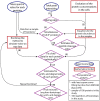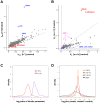A novel pulse-chase SILAC strategy measures changes in protein decay and synthesis rates induced by perturbation of proteostasis with an Hsp90 inhibitor
- PMID: 24312217
- PMCID: PMC3842330
- DOI: 10.1371/journal.pone.0080423
A novel pulse-chase SILAC strategy measures changes in protein decay and synthesis rates induced by perturbation of proteostasis with an Hsp90 inhibitor
Abstract
Standard proteomics methods allow the relative quantitation of levels of thousands of proteins in two or more samples. While such methods are invaluable for defining the variations in protein concentrations which follow the perturbation of a biological system, they do not offer information on the mechanisms underlying such changes. Expanding on previous work [1], we developed a pulse-chase (pc) variant of SILAC (stable isotope labeling by amino acids in cell culture). pcSILAC can quantitate in one experiment and for two conditions the relative levels of proteins newly synthesized in a given time as well as the relative levels of remaining preexisting proteins. We validated the method studying the drug-mediated inhibition of the Hsp90 molecular chaperone, which is known to lead to increased synthesis of stress response proteins as well as the increased decay of Hsp90 "clients". We showed that pcSILAC can give information on changes in global cellular proteostasis induced by treatment with the inhibitor, which are normally not captured by standard relative quantitation techniques. Furthermore, we have developed a mathematical model and computational framework that uses pcSILAC data to determine degradation constants kd and synthesis rates Vs for proteins in both control and drug-treated cells. The results show that Hsp90 inhibition induced a generalized slowdown of protein synthesis and an increase in protein decay. Treatment with the inhibitor also resulted in widespread protein-specific changes in relative synthesis rates, together with variations in protein decay rates. The latter were more restricted to individual proteins or protein families than the variations in synthesis. Our results establish pcSILAC as a viable workflow for the mechanistic dissection of changes in the proteome which follow perturbations. Data are available via ProteomeXchange with identifier PXD000538.
Conflict of interest statement
Figures






References
Publication types
MeSH terms
Substances
LinkOut - more resources
Full Text Sources
Other Literature Sources

